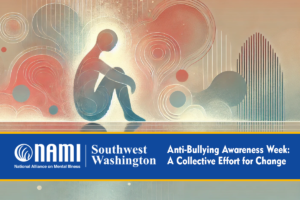By Damon Devine
My great-grandmother lost her husband, both sons and both grandsons to depression and suicide. And she almost lost me.
Grandma Fishel was my constant supporter during my tumultuous youth and adolescence. Her home became my refuge, my safe space away from the house I lived in and the school I attended — places where I struggled to fit in and knew I was different. She surrounded herself with cozy kitsch to bring light and cheer into her life. I’m convinced this environment was influential in shaping my lifelong love of “Old Hollywood” memorabilia and personal idols like Mae West and Yma Sumac.
Depression had been my unwelcome, relentless companion since age 11. Not situational depression that people experience as a normal part of life, but immobilizing, chronic depression with no obvious “reason.” Along with depression, even at that tender age, came thoughts of suicide. By the time I was a teenager, those thoughts were normal for me. I was resentful of how casual everybody seemed about daily life, while I was looking out a window at everyone else having fun.
At age 23, I started taking antidepressant medication. I had just moved away and was on my own for the first time; I knew I needed help to survive. It was hard admitting this to myself, much less anyone else — especially growing up in a family that didn’t talk about mental health, despite “the family curse” of suicide among our men. But I wanted to feel better and function in my new social and work environment. I was so relieved when the doctor took me seriously. The first medication helped for about six months. I felt much lighter, was much nicer to people, interacted more and could give more in my relationships.
Then the depression symptoms and suicidal thoughts came back — followed by the struggle of dealing with side effects and experimenting with doses and medication combinations. For many years, this was my routine to manage my depression. Looking back now, I never felt normal (whatever that is), even with medication; my existence just wasn’t as horrific. Sometimes I felt close to ok, but now I see that I never truly was.
TMS: The Treatment That Broke the Cycle
2018 was a really bad time for me, and the medications weren’t getting me through it. In my desperation to try something different, I remembered that some time back, my doctor had mentioned a non-drug treatment called transcranial magnetic stimulation (TMS) therapy. At the time, I hadn’t paid too much attention, but when I recalled the suggestion, I thought to myself that I must do this because I owe myself one last thing to try. If it didn’t work, I could at least say I gave it a chance.
TMS uses magnetic pulses to stimulate the brain, so it’s not another medication, and that appealed to me a great deal. The thought of facing another medication filled me with despair. If that had been my only option, I believe I would have given up.
I found a practice that specializes in TMS Therapy near where I live in Southern California, and thankfully, the doctor there diagnosed me as a good candidate. At first, I was intimidated when they told me I would have to come in every weekday for seven weeks. It was a struggle to get out of bed, much less leave the house and go out into the world. But I forced myself to go. After the first few days, I felt like I was doing something positive for myself, and I went every day for seven weeks.
The actual process and sensation of the daily TMS treatments were quite manageable. The office worked with me to schedule times that were convenient, and the practitioner I saw every day was wonderful. She got me settled into the comfortable treatment chair and made sure I received my exact, prescribed dose of magnetic pulses. For about 20 minutes, I sat in the chair and felt a tap-tap-tap sensation on my head where the magnetic coil touched my scalp and delivered the pulses.
Getting Better Surprised Me
I wasn’t sure how soon I would start to notice a difference. The doctor explained it’s different for everyone. My first sign was that the suicidal thoughts, which I had been having every day, stopped. After about 10 treatments, I had what I call my “Pop Day.” Colors seemed brighter, and I caught myself noticing how pretty traffic lights glow at sunset, photographing flowers on my way home from TMS and seeing beauty everywhere around me. I felt physically lighter, too. With depression, you feel heavy, like you’re carrying around a big bag of sand all the time, and that was gone.
When it worked, I couldn’t believe it. I still can’t believe it sometimes. Ever since Pop Day five years ago, things have never been as they were before. Even now, I’ll sit and think of how I feel today and marvel at the difference. I find myself adapting to situations that would have seemed insurmountable back then.
Treatment Is Lifesaving
Coming out of depression felt like coming out of prison, even though I’d done nothing wrong. The person I always knew was deeply trapped in all that sadness, angst and exhaustion came out. I always knew there was a pretty cool person in there.
TMS was the treatment that worked for me, and it might work for you. The important thing is to ask for help and muster up the strength to follow through. Whether it’s TMS or something else, you don’t have to wait until you’re in as dangerous a place as I was. I hate to say the overused phrase, “If I can do it, you can.” But it’s the truth. I’m no one special, but I am somebody to relate to, and I understand.
Damon Devine is a mental health advocate who wants people to know that mental illness is not their destiny or their identity. He encourages everyone to be aware of their treatment options before they’re in crisis.




